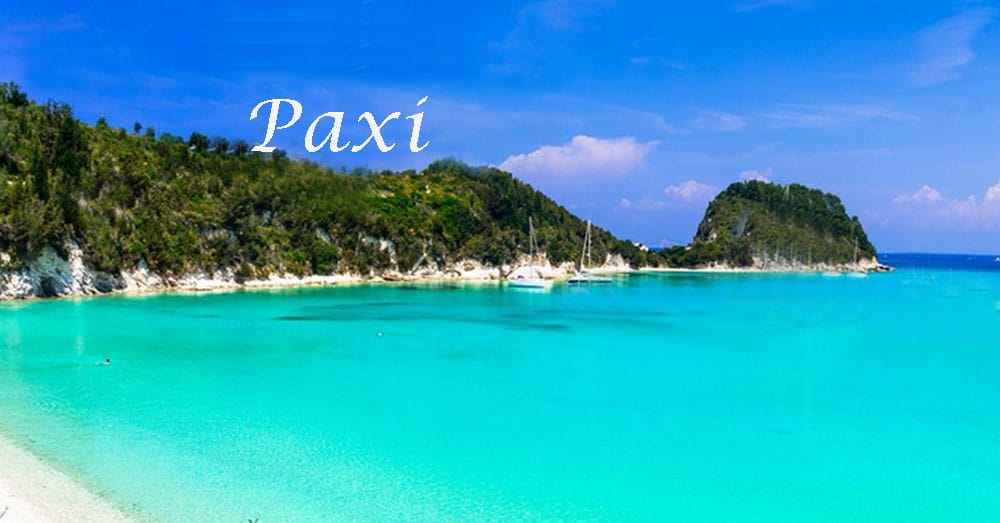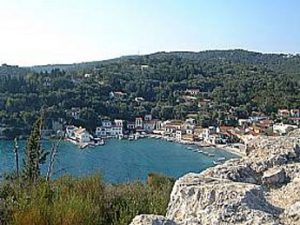Information about Paxi
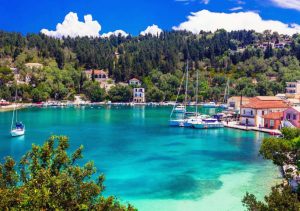 Paxi is one of the most beautiful islands of Greece, a true jewel of the Ionian Sea. It is an ideal destination for relaxing holidays under the summer sun with picturesque landscapes as a background.
Paxi is one of the most beautiful islands of Greece, a true jewel of the Ionian Sea. It is an ideal destination for relaxing holidays under the summer sun with picturesque landscapes as a background.
According to tradition, Paxi was once united with Corfu. But Poseidon grabbed the piece with his trident and detached it, so that he could there live undisturbed his love with Amphitrite.
The picturesque fishing villages, the amazing beaches and the sense of luxury that the island exudes will enchant you.
Paxi is an immense olive grove. Its eastern coasts are smooth, while the western ones are steep, with remarkable formations: caves, arches, domes, vertical cliffs. The capital of Paxi is Gaios, a picturesque village built in the harbor, protected by two islets, Agios Nikolaos and Panagia. On the northern side is Lakka and on the eastern beach is the picturesque Logos.
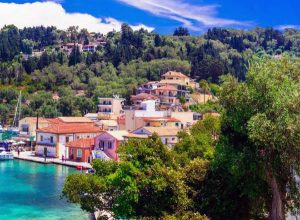 Although Paxi is the smallest island of the Ionian Sea, it offers many options for activities. The western part of the island is dominated by impressive, wild landscapes, while the southern side has a milder, cosmopolitan character. In Paxi there are many beautiful Byzantine churches and places of historical and cultural interest.
Although Paxi is the smallest island of the Ionian Sea, it offers many options for activities. The western part of the island is dominated by impressive, wild landscapes, while the southern side has a milder, cosmopolitan character. In Paxi there are many beautiful Byzantine churches and places of historical and cultural interest.
In Gaios you can see the castle of Ai Nikolas on the islet of the same name, the Museum of Paxi, the cisterns of Eleusis, the cistern of the Holy Apostles, the cistern of Agioi Anargyro and the Lesianitis mill.
In Lakka it is worth visiting the house of Drihoutsis and the lighthouse. In Magazia you will be able to taste the famous seafood of Paxi in one of the picturesque shops. In Logos, the factory of Anemoyiannis dominates the edge of the settlement.
Although Paxi is the smallest island of the Ionian Sea, it offers many options for activities. Start with a walk in the alleys of Gaios, go around the island by boat, visit the Venetian castle of the island of Agios Nikolaos, the English Government and the Museum of Paxi.
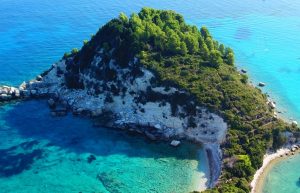
It is worth getting to know the paradisiacal green island of AntiPaxi, just three nautical miles from Paxi, where you can reach by boat from most of the settlements of Paxi, but also by private boat. The island is and has dreamy beaches with turquoise waters, the most famous being Voutumi and Vrika, which are considered among the most beautiful beaches in the Ionian Sea.
History

Although we know little about Paxi from the period of antiquity, what is certain is that their name has been preserved since then.
According to historical sources, in 229 BC the Corcyraeans were defeated in a naval battle by the Illyrians of Queen Teutas and together with the Paxi fell to them for a short period of time until her death in 228 BC.
Then Corfu with the island complex of Paxi came under the influence of the Romans. In the centuries that followed, the Paxi followed the fortunes of Corfu. From the 13th century they came under the rule of the D’Anjous and from 1386 to the Venetians.
During the Venetian rule which lasted until the end of the 18th century, Paxi and AntiPaxi were threatened many times by pirates which led, in 1423, Baron Adam II of San Hippolytos to request permission from Venice and build two castles, one in the gulf of Gaios, on the islet of Agios Nikolaos and one in Lakka. The Venetians were also the ones who, through the feudal system they implemented, intensified olive cultivation.
Geography
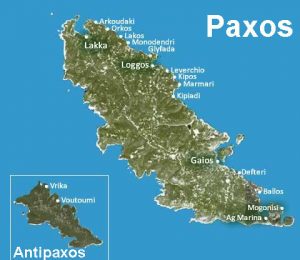
The west coast is dominated by white chalk cliffs, eroded at sea level to create the island’s famous ‘blue caves’. The east is gently sloping and is where most of the beaches are found, such as they are.
Two asphalt roads run the length of Paxos, from Gaios in the south to to Lakka in the north. Much of the interior of Paxos is olive groves. Paxos is a favourite island of wealthy Italians so expect to find many palatial villas and the highest-priced real estate in Greece.
The islet of Antipaxos, to the south, is a favourite target of day trip boats ferrying holiday visitors to its two sandy beaches.
Weather
Paxi has plenty of winter rain which helps compensate for the lack of natural springs and many houses have large water tanks to store winter rainfall.
March, April and May are good for walking as temperatures are comfortable and the island is full of wild flowers.
Paxi has long hot summer days from June to September, turning changeable in October and with longer spells of rain from November to March.
Villages
There are three main villages on Paxos of which Loggos is the tiniest and, for us at least, it just seems the friendliest and least spoilt. It’s everyone’s idea of a typical Greek fishing village. One of their major concessions to commercialization was to string a row of fairy lights along the harbour front some years ago, but each year we went back, more and more bulbs were in need of replacing, and after about 3 years they had taken them down altogether! Loggos has about half a dozen tavernas, the same number of bars and a handful of shops – so everything you need really.
Loggos
Most ferries to Paxos arrive at the toytown port of Gaios, named after the saint who brought Christianity to the island. Tiny, compact and very attractive, Gaios has a crescent quayside backed by a handsome Venetian square.
Cafes and tavernas fringe the harbour and day trippers provide plenty of business for the locals. The streets may be too narrow for cars but it is not unknown to get stuck in human traffic in the high season.
A couple of outlying islets, Agios Nikolaos and Panagia, provide natural protection and pleasant views even if only glimpsed through the myriad masts of the moored yachts.
Whitewashed alleys lead off the main square, stuffed with souvenir shops, although the wares are more sophisticated than usual with good pottery and fine jewellery always on show.
Worth seeing are the castle of Agios Nikolaos, although a permit is needed from the local council and the monastery on Panagia islet. The Church of Agios Apostoli behind the bus stop has many fine icons and there is an ancient cistern to the right of the church.
Gaios
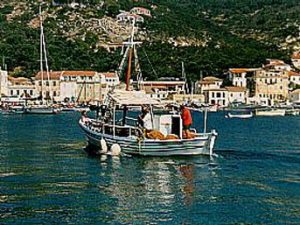
Gaios it gets very busy during the day with trippers from Corfu and Parga and many of the shops seem to be aimed at making a quick killing from these daytrippers.
Loggos is the smallest of the ports on Paxos and even more photo-snappingly picturesque than Gaios with clusters of flower-decked houses overlooking the small fishing harbour.
Picturesque seclusion sells this place which often doubles as a film set, especially the east-facing quayside which is an ideal spot for alfresco breakfast although early risers snap up the best tables at the waterside tavernas. Visitors claim Loggos outshines the other resorts for the quality of taverna food and it pays to book in the busiest summer months. Besides the waterfront tavernas and a few cafes, Loggos has three mini -markets, a bakery and a several tourist shops.
At the end of the harbour stands the tall chimney at a disused soap factory. Several plans have been put forward to develop the site.
Loggos hosts the Paxos International Music Festival, usually in August or September, with events centred in the old school house.
Lakka
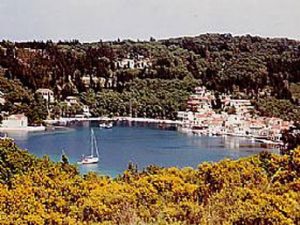
The port resort at Lakka is approached through an avenue of new apartments. The least picturesque of the ports, Lakka still has a friendly, less inhibited air and a trip to Lakka may make the other ports seem snooty in comparison.
Lakka sits in a lovely horseshoe bay flanked by silver green olive groves and stands of cypress. The village has a small square edged with Venetian buildings and fed by a maze of narrow alleyways.
There are plenty of shops and mini-markets as well as a fair number of tavernas and Italian restaurants. Music bars can stay open until the early hours.
Lakka struggles with the volume of day trip traffic and boats will often queue to get through the narrow strait and into the bay to tie up at the crowded quayside.
Ferries from Corfu arrive at noon and stop for two to three hours and tavernas have multiplied to meet the demand, often making Lakka a noisy place in the early afternoons.
This is the best centre for island walking and there are several good trails heading inland or along a coast that offers some spectacular cliffside views.
What to do
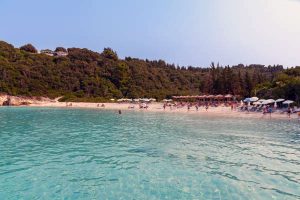
Hired boats are not allowed here so the only way to see it from the sea an excursion boat. You can walk coastal paths but, of course, you don’t get to experience the majesty of the cliffs, although there are spectacular views.
The sea caves are impressive and quite the best anywhere in the Greek islands. Some of the caves are large enough to take pleasure boats and visitors are taken inside. The cave at Kastanitha is the most impressive at 600 ft high though the largest is found at Grammatiko. All of the caves are worth a visit.
The views from the cliffs above Ermitis Bay are very popular with visitors , particularly at sunset and the local Sunset Bar is a very popular place in the evening. Follow the signs from the hamlet at Biokatika to get to it.
Antipaxos island
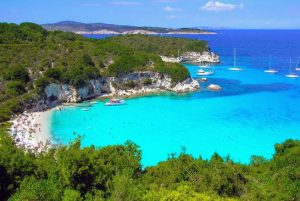
There are houses on Antipaxos islet, which lies south of Paxos, but they are not occupied all year round. They are used by families that have vineyards there.
Excursion boats to Antipaxos are frequent in the summer and the journey time is only about 15 minutes. A daily Antipaxos Lines boat leaves Gaios at 10am and returns at 5pm.
There are two beaches on Antipaxos, both at the northern end of the islet. Vrika is sandy and Voutoumi is pebble, though sandy underfoot in the water.
The white sand and pebbles make for clear turquoise seas and some of the best swimming and snorkeling to be found in the Ionian. There are beach tavernas at both spots in the summer and paths run south where several quiet coves can be found.
Day trips
For a lot of people, their first experience of Paxι is on a daytrip from Corfu. There are many organised trips available, but most of them only seem to give you a couple of hours actually on the island and time for a quick swim when the boat moors off a beach on Anti Paxos, so they are more about the trip itself than actually seeing Paxι.
For anyone who is more interested in “being there” than “getting there”, we recommend going independently by either hydrofoil or seaplane. The seaplane only takes about 15 minutes, as opposed to an hour by hydrofoil, but the timings mean that on a daytrip you don’t actually get that much longer on Paxos than by taking the hydrofoil .
However, the views from the seaplane are supposed to be breath-taking, so it’s worth considering the extra expense for at least one leg of the trip. If travelling by hydrofoil, we recommend going on a Wednesday or Sunday, when the Paxos Flying Dolphin leaves Corfu at 9.30 am and returns from Gaios at 5pm. This gives you around 6.5 hours to either explore Paxi, using a combination of bus and taxis, or to get one of the express boats that run from Gaios to Anti Paxos about once an hour throughout the day.
Boat Trip around the island
A trip around the island by boat is a must for dramatic views of the western caves and cliffs. Some boats are small enough to actually sail inside some of the caves and the rock formations and colours are absolutely stunning. The best tour is to Lefcothea from Loggos harbour and it cost about 15 – 25 euros each for a full day, including about 4 hours on Anti Paxos. You leave Loggos at 10.30am and arrive back there at around 5.30pm. The highlight of the trip is swimming in the clearest, bluest sea, in one of the tiny coves on the west coast of Paxos. Lefcothea is run by Paxos Thalassa Travel and can be booked in their office on Loggos harbourfront.
Hydrofoils and Seaplanes
The hydrofoils to Paxos leave from Corfu New Port, just behind the Nautica Bar and opposite Hotel Atlantis and are quite frequent during the high season June – September. The journey takes about an hour. The seaplane service started up in November 2004 and runs from Gouvia Marina. During the summer of 2005 it was only operating between Corfu, Paxos and Ioannina but there are plans to run scheduled flights all over the Ionians and to Brindisi and Patras next year. The current service cuts the travel time between Corfu and Paxos to around 15 minutes.
Beaches
The beaches in Paxi have turquoise waters, golden sand and white pebbles. Many are accessible by land, while others are only accessible by boat and most are not organized.
Blue-green waters, golden sand and white pebbles await you at the fairytale beaches of Paxi, many of which are accessible by land, while others are reached by boat.
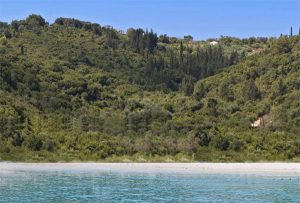
Visit the beaches of Paxi such as Kipiadi, Monodendri, Marmari, Plakes, Galazio, Planos, while it is worth visiting the islet of Moggonisi which is accessible by road and there you will find one of the few sandy beaches in Paxi, with wonderful shallow waters.
Because most of the beaches of Paxi are unorganized, before going to the beach, you should stock up on umbrellas and mats or visit one of the organized ones to begin with which are Manadendri beach in the north-eastern part of the island or Paxos beach in the south-eastern part of Paxos .
Visit one of the unorganized beaches of the island with the first and best being Kipiadi beach which is ten minutes from the port of Gaios and has a two minute walk right from where you will park. The not-so-clear sign will show you that you have arrived in the right place, the white stones and the deep blue waters will welcome you to a beach without too many people and noise.
By buying a map of the island, you will find that you have many choices of beaches, with the best being Kaki Lagada, Kepiadi, Kipos, Marmari. All of these are located on the eastern side of the island.
Erimitis beach on the west side of the island is one of the best. Although it is located in the difficult and wild part, there is access to a certain point by car or motorbike and then for about 5 minutes of walking. The place is stunning, the sunset is great and the best, it is not very crowded. Recently there was a big landslide and the beach opened up even more.
Where to stay
Paxi is a favourite island retreat for wealthy Greeks and Italians so visitors will find no end of luxurious villas are dotted all over the island.
Most of the accommodation centred around Gaios and there are cheap rooms to be found, although this becomes increasingly difficult during the high summer season.
Much of the available accommodation on Paxi is block-booked by tour operators – most at the upper end of the holiday hotel market.
Although there is a wide variety of holiday rental accommodation available on, Paxi ranging from ‘domatia’ rooms to luxury villas with pools and five star hotels the independent traveller will find much more on offer out of season.
There are rooms to be found in the three main resorts of Gaios, Lakka and Loggos and there are several property agents in Gaios that will try to find rooms or apartments if you ask but don’t hold your breath.
Moving around
Roads have improved on Paxi over the last few years. The two main asphalted roads run the length of the island from Gaios to Lakka, one follows the east coast, the other the west, with narrow paved roads, dirt tracks and mule trails branching off off to the various beaches and clifftop sightseeing spots.
An air conditioned minibus runs a regular round-trip service four times daily between Gaios, Loggos and Lakka. There is a large taxi rank at Gaios and taxi ranks can be found at Lakka and Loggos. Fares are regulated. Bike and car hire outlets are plentiful in Gaios.
There are several car hire firms on the island but, in high season, demand can exceeds supply so it’s best to book in advance. Roads are very narrow in places and many are steep and have large potholes or broken edges.
There were only five taxis on Paxi at the last count and they get heavily booked for hydrofoils and ferry arrivals and departures.
Paxi is a good island for walking with scores of tracks criss-crossing the island and visitors are never far away from a small village or hamlet. The island is an endless olive grove, terraced with stone walls with many of the trees planted during Venetian times.
There are around 150 old stone olive-presses, 60+ chapels and several windmills on Paxi. The Bleasdale Walking Map of Paxi, available from many shops, details 53 footpaths and Sunflower Books also publishes a walking guide to Paxi.
The best walks can be found around Lakka with great views to be had while the road from Gaios to Loggos offers good walking with the hamlet at Fondana for a rest half-way.
How to get to Paxi
By air
There is no airport on Paxi. Most visitors get a charter flight to Corfu and then catch one of the regular ferries to Paxi.
Mondays is the main day for charter flight arrivals and departures over the summer for visitors to Corfu and Paxi.
Cheap flight carriers Easyjet and Ryanair fly on different days from March to November from various UK airports.
In addition to the many package charters are daily domestic flights to Athens and to Thessaloniki. The flight from either city is about 50 minutes.
For information on flights call the airport on 2663 030180. An alternative options is a flight to Athens and an overland bus to Igoumenitsa where there is a daily ferry connection. This bus service only operates three days a week so the route will rake some organising.
Hopes are high that seaplane services will start from Corfu in the summer of 2015 after the port was granted a licence to to launch seaplane services.
By ferry
A number of ferry operators run routes from Corfu to Paxi and there is a ferry service on most days.In summer a hydrofoil service runs from Corfu to Paxi every day, twice a day on Thursday, Saturday and Sunday and three times on Monday. the last service leaves Corfu at 2.30 pm most days but 5.30pm on Mondays and 6.45pm on Sundays.
The service is run by Corfu Tourist Enterprises and tickets can be booked in advance on 0030 26610 49800/80444 or from ilidaii@ymail.com or Paxiilida@yahoo.com. Reserved tickets are picked up on the boat.
Kamelia Lines run the Despinia passenger ferry between Corfu Town and Paxi daily throughout the summer and also a service from Paxi to Lefkimi, in south Corfu, on Mondays with a reduced winter service. There is no Sunday service out of season and weekday services are reduced.
S&L Ferries also operate daily crossings from Igoumenitsa and tickets can be obtained on 0030 2665021000. They have a website but it was more style than substance the last time I looked.
Private high speed sea taxis operate between Paxi and Corfu but they are not cheap. Expect to pay from €250 – 300 for the journey. The Paxi Express is operated by Paxi Sea Taxis with a journey time of 60 minutes from Corfu Town and 30 minutes from Lefkimi. They also runs services to Igoumenitsa. Contact the Paxi Express on 0030 6932 232072 or email info@Paxiseataxi.com. Faoulias Lines also operate the Lakka Express sea taxi service. They can be contacted on 0030 6977623033.
A wide selection of motor boats are for hire from Gaios, Lakka and Loggos. No licence is needed for boats up to 30HP but an ICC is required for more poerful boats.
Excursion boats also leave daily to tour the white cliffs and sea caves of the west coast including huge caves at Ipapanti, and Ortholithos. The other big west coast attraction sis the huge Tripidos arched rock formation.
Tips for travelers
This is where I’ll put anything that doesn’t really fit into any of the other headings and hopefully will add to it from time to time as different ideas spring to mind.
Money on Paxi
If you’re used to using ATMs to get cash on holiday, it’s handy to know that, as far as I’m aware, the only ones on Paxi are still in Gaios. There was talk of one being installed in Lakka a while ago, but I seem to recall someone telling me that it was just a “hole in the wall” and didn’t actually work! If anyone knows different, please let me know. Credit cards are widely accepted on the island nowadays, but you will need some cash for small day-to-day purchases and Paxi is one of the few places in the world where I wouldn’t have any qualms about taking a wad of euros with me and not needing a safe to keep them in. Several of the tour offices in Loggos and Lakka exchange cash or travellers’ cheques and seem to give a reasonable exchange rate with about 1 – 2% commission and if you happen to travel with Planos, they have a fantastic scheme whereby they allow you to “run up a tab” for cash throughout your holiday and then settle it with a normal personal cheque before you go home.
Packing Tip
Paxi isn’t so isolated that if you forget to take anything essential with you, you won’t be able to find one somewhere on the island, but one thing that I always try and remember to take with me is a torch for walking home at night. Outside the village centres even the “main” roads are badly lit at night and to reach your accommodation, you may find yourself having to stumble along narrow winding goat tracks or up donkey steps, which are very picturesque in the daytime, but no so easy to negotiate in complete darkness. Especially not good after a few ouzos or metaxas!
Transport around the island
There is a public bus that goes between Gaios and Lakka via Loggos a few times a day, but it’s not very frequent and for most of the year stops running at around 6.30 in the evening. It does run later during the peak season, but nobody ever seems to be sure exactly when this will start (it was around 18th July this year I think) and even then the last bus from Gaios is about 10pm and from Lakka to Gaios about 10.30, so it’s not exactly designed for late nights out! There are a few taxis on the island, but you never seem to be able to find one when you need it, so if you’re planning a late night out of your home village, or need to be somewhere by a set time – like catching a ferry home – it’s always best to try and book in advance. There are plenty of cars, bikes and boats to hire on Paxi though, so there’s no need to be stuck in one place all holiday if you don’t want to be. Mind you, I’m usually quite happy to be “stuck” in Loggos for as long as I possibly can be!
